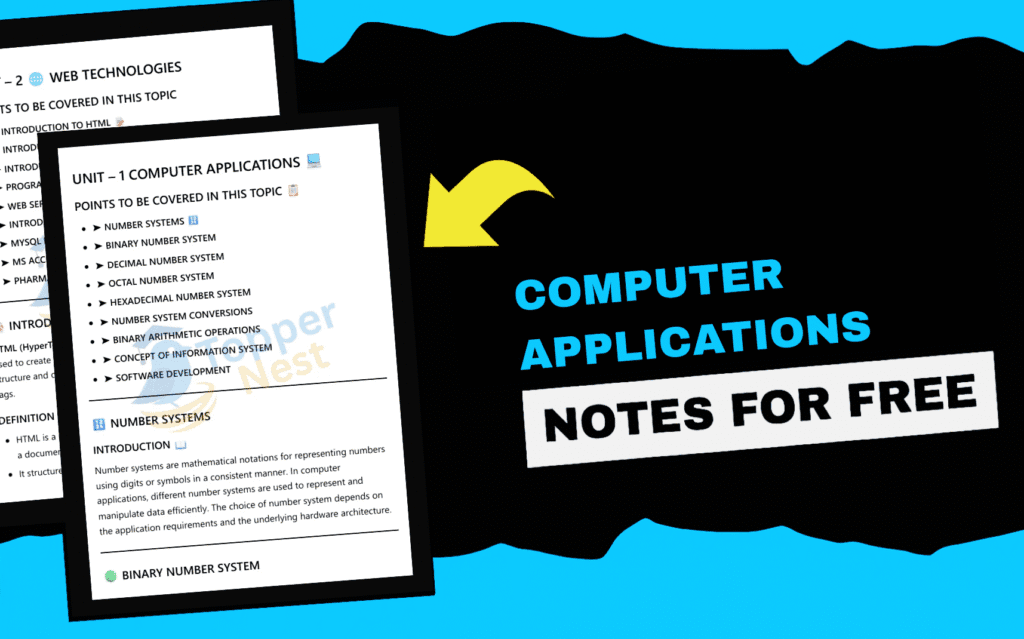Starting your professional course journey? One of the most essential subjects you’ll encounter in your first year is Computer Applications in Pharmacy. This subject builds your foundation in the use of computers and digital tools in pharmaceutical sciences, focusing on how technology supports drug design, data management, hospital systems, and patient care. It is vital for understanding modern pharmacy practices and research advancements.
Our Computer Applications in Pharmacy Notes are carefully prepared to make your study experience simple, well-structured, and exam-focused. Whether you need clear explanations of drug information systems, pharmacokinetics modeling, hospital and clinical pharmacy applications, electronic prescribing, barcoding, automated dispensing, mobile health technologies, or patient monitoring systems, these notes are designed to help you grasp the concepts thoroughly and retain them effectively.
These notes will not only support your classroom learning but also serve as a quick reference guide before exams. With system diagrams, step-by-step explanations, important definitions, and practical examples, Computer Applications in Pharmacy Notes make your preparation easier, more efficient, and exam-ready.

What is Computer Applications In Pharmacy?
Computer Applications in Pharmacy, often included as a core or elective subject in B.Pharmacy programs, refers to the use of information technology (IT), software, and computational tools across all aspects of the pharmaceutical field.
Its main purpose is to improve efficiency, accuracy, and patient safety in drug discovery, manufacturing, dispensing, and clinical management.
Core Areas of Application
The applications of computers in pharmacy are vast, spanning both scientific research and patient-facing practice:
1. Drug Discovery and Design (Cheminformatics/Bioinformatics)
This is a high-level application where computational power replaces or speeds up traditional lab work:
- Computer-Aided Drug Design (CADD): Using software to model and predict how a potential drug molecule will interact with a biological target (like an enzyme or receptor). This drastically reduces the time and cost of synthesizing and testing new compounds.
- Molecular Modeling: Simulating the 3D structure and behavior of drugs and biological targets.
- Data Mining: Analyzing massive biological and chemical databases to identify patterns and potential drug leads.
2. Pharmaceutical Manufacturing and Quality Control
In the industrial setting, computer applications ensure efficiency, quality, and compliance:
- Process Control Systems: Automated systems regulate and monitor variables like temperature, pressure, and mixing speeds during drug production to ensure consistent quality.
- Quality Management Software (QMS): Systems used for electronic documentation, tracking deviations, managing change control, and ensuring compliance with Good Manufacturing Practices (GMP).
- Inventory and Supply Chain: Computerized systems optimize the movement of raw materials, track batches, and manage the complex logistics of drug distribution.
3. Dispensing and Practice Management
In hospital and retail pharmacy settings, computers are essential for daily operations and patient safety:
- Electronic Health Records (EHR) and E-Prescribing: Systems that allow doctors to send prescriptions electronically and provide pharmacists with a complete, integrated patient history, reducing errors from handwritten scripts.
- Dispensing Software: Programs that manage prescription processing, label printing, dosage calculation, and automatic Drug Utilization Review (DUR) to check for allergies, drug-drug interactions, and contraindications.
- Automated Dispensing Machines: Robotics and computer-controlled systems that count, package, and label medications, minimizing human error.
4. Patient Information and Education
- Pharmacovigilance: Using large databases and software tools to monitor and report adverse drug reactions (ADRs) once a drug is on the market.
- Patient Counseling Software: Programs that provide clear, customized drug information sheets and educational videos to patients based on their specific medication regimen.
Unit-wise Notes for Computer Applications
Why Computer Applications is Important in B. Pharmacy
The importance of Computer Applications in Pharmacy in the B.Pharmacy curriculum cannot be overstated, as modern pharmacy is entirely reliant on digital technology. This subject equips future pharmacists with the essential digital literacy and computational skills needed to succeed in a technology-driven healthcare environment.
Here are the key reasons why this subject is crucial:
1. Enhancing Patient Safety and Accuracy
Computer systems are vital for minimizing human error in the dispensing process, which is a core professional responsibility.
- Drug Utilization Review (DUR): Pharmacy software automatically screens every prescription against a patient’s profile to check for potential drug-drug interactions, known allergies, therapeutic duplications, and inappropriate dosing. This instant computational check is far more accurate and faster than manual verification.
- E-Prescribing and Electronic Health Records (EHR): Using digital systems eliminates the risk of errors from handwritten prescriptions, ensures accurate patient histories, and standardizes data, leading to safer and more coordinated care.
- Inventory Control: Accurate, computerized inventory management prevents stock-outs of essential medications and helps track expired or recalled drugs, protecting the public.
2. Streamlining Research and Drug Discovery
In pharmaceutical research and development, computational methods have become indispensable for speed and efficiency.
- Cost and Time Reduction: Computer-Aided Drug Design (CADD) allows researchers to rapidly screen thousands of potential drug molecules in silico (via computer simulation) before expensive and time-consuming laboratory synthesis and testing.
- Modeling and Simulation: Pharmacists involved in research use computer applications to model the absorption, distribution, metabolism, and excretion (ADME) of drugs, helping predict how a drug will behave in the human body.
- Bioinformatics: Specialized software is used to analyze large amounts of genomic and proteomic data, which is essential for developing personalized medicine and understanding drug targets.
3. Improving Professional Efficiency and Compliance
For both hospital and retail pharmacists, computer applications transform day-to-day operations.
- Automation of Tasks: Automated dispensing systems, controlled by specialized software, can count and label medications faster and with higher accuracy than a human, freeing the pharmacist to focus on patient counseling.
- Regulatory Compliance: Computer systems ensure that dispensing practices comply with federal and state regulations, manage billing (especially with insurance and government programs), and maintain detailed, auditable records as required by law.
